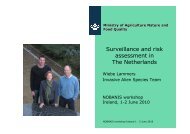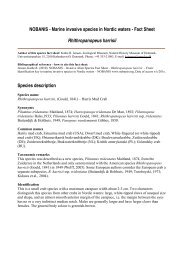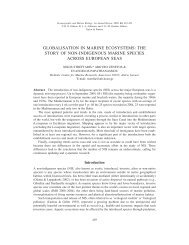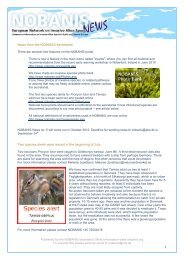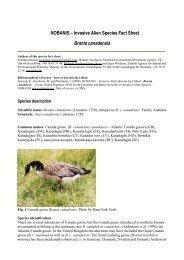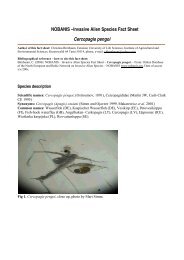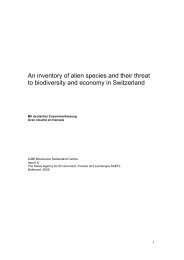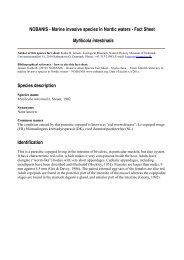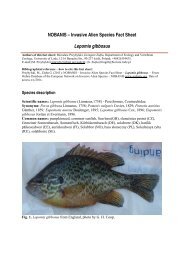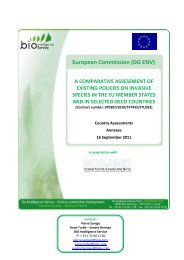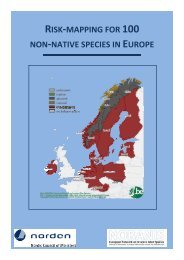Invasive Alien Species Fact Sheet – Mustela vison - NOBANIS
Invasive Alien Species Fact Sheet – Mustela vison - NOBANIS
Invasive Alien Species Fact Sheet – Mustela vison - NOBANIS
You also want an ePaper? Increase the reach of your titles
YUMPU automatically turns print PDFs into web optimized ePapers that Google loves.
weeks. The exclusive nursing period is 25 days. The males do not participate in rearing the young,<br />
who begin their first independent forays in July. The family breaks up in August and September.<br />
The turnover of wild populations of M. <strong>vison</strong> takes place in three-year periods; in captivity the<br />
animals may live for 10 years. Swedish investigations have shown that 84% of the animals in the<br />
wild live for only one year (Stubbe 1988). In western Poland daily survival rate in each season<br />
declined from 0,989 in autumn-winter to 0,977 in spring. Probability that <strong>Mustela</strong> <strong>vison</strong> would<br />
survive the whole season is only 0,1351 in autumn-winter and decreases to 0,1203 in spring. Many<br />
M. <strong>vison</strong> are killed on the roads, but their numbers are quickly replaced by an influx of new animals<br />
(Bartoszewicz and Zalewski 2003).<br />
According to Stubbe (1993), stable populations may establish themselves rapidly in vacant habitats<br />
lacking predators, and the population size then depends mostly on food availability and territorial<br />
behavior. Studies conducted in several northern European and North American habitats have shown<br />
that territories are 0.3 km (in Warta Mouth National Park <strong>–</strong> western Poland) to 6 km in length on the<br />
average. Animals of the same sex are not tolerated within the territory, and migrants lacking their<br />
own territory keep to the waterways. However they are able to cross areas considered hostile to M.<br />
<strong>vison</strong>, i.e. large fields, highways and railways (Meier 2005). In Warta Mouth National Park, where<br />
M. <strong>vison</strong> density is very high, territories of males overlap very often to a high degree <strong>–</strong> 44,2%<br />
during autumn-winter season and 55,0% in spring. Common space utilization can be caused by<br />
abundance of food supplies (Bartoszewicz 2003).<br />
Dispersal and spread<br />
The abandonment of agriculture in wetlands and the resulting emergence of reed belts and willow<br />
and alder shrubbery lead to an expansion of possible M. <strong>vison</strong> habitats (Schmidt 1985). Highlands<br />
with dense conifer forests e.g. the Fichtelgebirge and the Thuringian Forest, on the other hand,<br />
represent a barrier to the dispersal of M. <strong>vison</strong> (Kraft and van der Sant 1999).<br />
A cause for dispersal and spread of M. <strong>vison</strong> may also be "liberations" by animal protection activists<br />
(Skirnisson 1992, Kraft and van der Sant 1999), and insufficient precautionary measures on the<br />
farms - captures of 20 to 50 animals per year in the immediate vicinity of the farms were not<br />
unusual (Stubbe 1975).<br />
Impact<br />
Affected habitats and indigenous organisms<br />
M. <strong>vison</strong> affects indigenous animals by competition and is suspected of displacing its relative, the<br />
European mink, <strong>Mustela</strong> lutreola (which is threatened by extinction), and the European polecat,<br />
<strong>Mustela</strong> putorius (Schröpfer 1999). In Estonia the most serious effect of <strong>Mustela</strong> <strong>vison</strong> is its<br />
competition and intra-guild aggression with <strong>Mustela</strong> lutreola (European mink) (EU LIFE project,<br />
Kull 2005). In Denmark there are also concerns about the damage that M. <strong>vison</strong> may cause to<br />
polecats (<strong>Mustela</strong> putorius) and otters (Lutra lutra) (Hammershøj 2004). On the other hand, it has<br />
been suggested that the otter may be a stronger competitor for food and space, and thus may lead to<br />
local declines in the <strong>Mustela</strong> <strong>vison</strong> population (Jędrzejewska et al. 2001, Bonesi and Macdonald<br />
2004, Bonesi et al. 2004).<br />
Another effect of M. <strong>vison</strong> is as a predator. Its main food consists of fish, which may inflict serious<br />
damage on fish cultures (e.g. in Iceland, Sweden and England) (Skirnisson 1979), birds and small<br />
mammals, but it may also subsist on e.g. crustaceans, berries, amphibians and even carcasses<br />
(Dunstone and Birks 1987, Niemimaa and Pokki 1990, Jędrzejewska et al. 2001). The prey<br />
composition varies with the seasons (Skirnisson 1979) and also depends on the habitat (e.g. coast or<br />
inland waters).<br />
4



